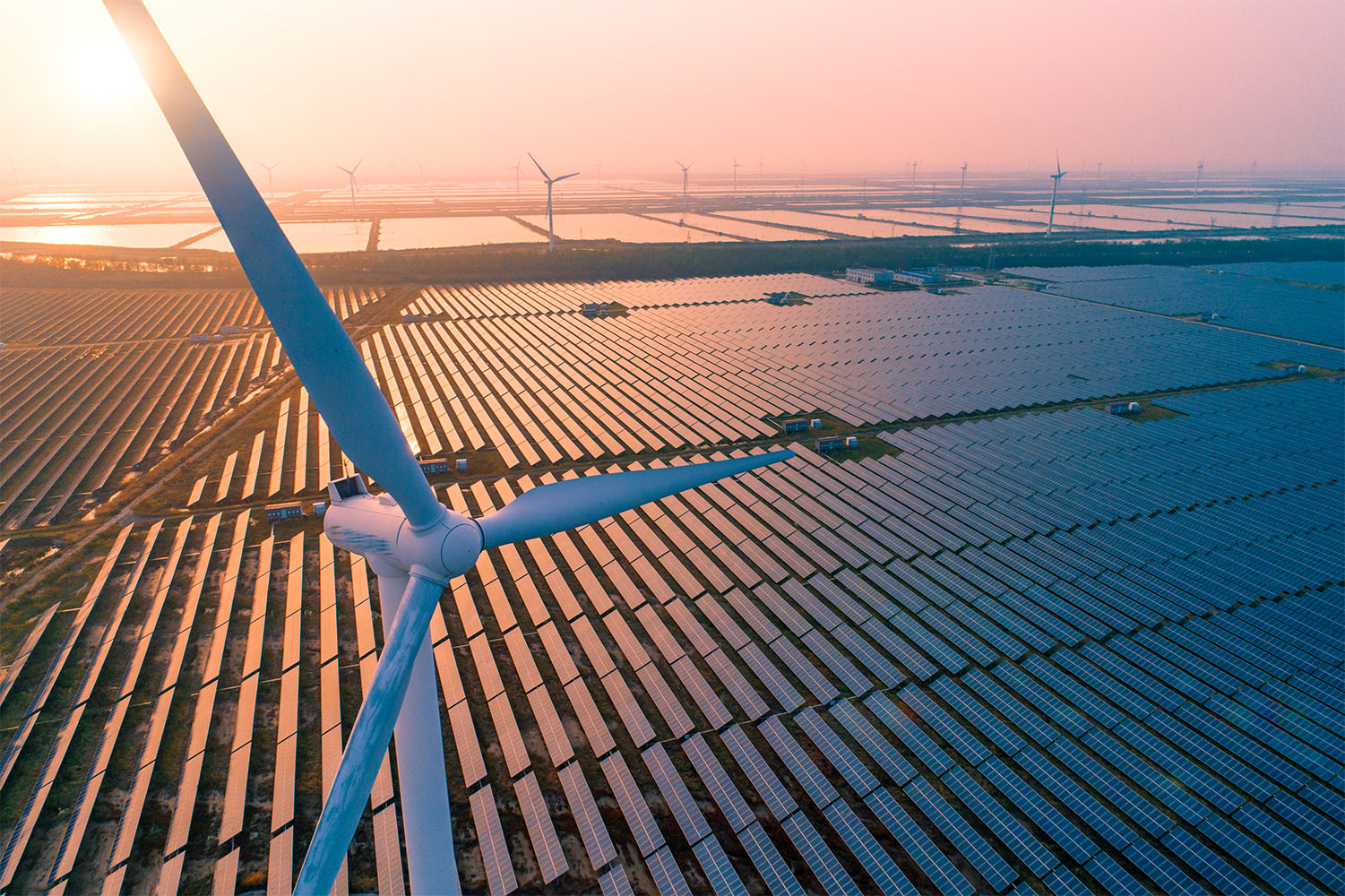Hybridisation of renewable energy generation installations raises regulatory issues in Spain
Published on 8th June 2023
Hybridising existing installations can increase renewable generation in the energy mix and optimise electricity grid use

In 2012, the installed photovoltaic power in the Spanish Electricity System (SES) was 4,233 MW and wind power was 21,167 MW. By the end of 2022, the SES had 19,941 MW of installed photovoltaic power and 30,016 MW of wind power, which means that, over a period of 10 years, the installed photovoltaic power increased by 371% and wind power by 50%.
This rapid and sustained increase in the installed capacity of renewable energies, which is so necessary to achieve the energy transition, has turned grid access capacity into a resource that is in high demand but is scarce and, therefore, of great value. It is in this context that the hybridisation of electricity generation installations has arisen and is regulated.
The regulation of hybridisation in Spain was introduced by Royal Decree-Law 23/2020, approving energy and other measures for economic reactivation, which amended the Electric Sector Law to introduce the possibility of hybridisation of installations. Shortly afterwards, Royal Decree 1183/2020 on access and connection to electricity transmission and distribution networks was approved, which regulates, among other important issues for the sector, the possibility of hybridisation projects for existing generation installations using the same connection point and access capacity already granted, as well as the hybridisation of new installations without prior access and connection permits. This regulation completed by Circular 1/2021, of the National Markets and Competition Commission (Comisión Nacional de los Mercados y la Competencia), on the methodology and conditions for access and connection to the transmission and distribution grids of electricity generation installations.
Hybridisation is the generation of energy using two different generation sources or a generation source and a storage source with the same connection point to the grid. Behind hybridisation is a very simple reasoning: renewable generation technologies, and we are referring mainly to photovoltaic and wind power, are intermittent in generation, but this intermittency is complementary, i.e., in periods when one of the technologies is inactive or low in generation and, therefore, there would be an underutilisation of the grid, the other technology can produce and feed into the grid, complementing each other and optimising the use of the grid.
The regulation of hybridisation allows it to be carried out both in existing installations to which a new generation or storage technology is added and in new projects that are proposed with two generation technologies or one generation and one storage technology. In both cases it is necessary that the hybrid installation includes at least one electricity generation module using renewable energy sources or a storage installation.
Hybridisation of existing installations
Hybridising an existing installation has the great incentive of being able to evacuate using the same connection point and grid access capacity already recognised by the existing installation; that is, it is possible to hybridise an existing installation by incorporating a new generation or storage technology without the need to apply for a new grid access permit and using the capacity granted by the existing permits to discharge energy.
The promoters considering the hybridisation of a generation installation that already has access and connection permits must take into account the existence of certain requirements, including the following:
- Hybridisation does not involve increasing the granted access capacity by such an amount that the installation is no longer considered the same. In other words, the access capacity granted cannot be increased by more than 5% of that granted in the original access permit, as this is the limit that the regulation establishes for considering an installation to be the same.
- The owner of the installation to be hybridised must already have a valid access and connection permit for at least one of the electricity generation modules.
- The installed capacity of the technology for which the access and connection permit has already been granted may not be less than 40% of the granted access capacity. For example, if the access capacity granted to a photovoltaic project is 10 MW and this project is later hybridised, the installed photovoltaic power may in no case be less than 4 MW. This limitation is set in order to avoid hybridisation being used to substitute one technology for another.
Special conditions of the hybridisation of existing installations
Hybridisation of this type is also subject to a number of special conditions. Firstly, it will be necessary to update the access permit and connection of the generation module, as well as to deposit a new guarantee for the new technology to be introduced. This guarantee is reduced by 50%; that is, the guarantee to be deposited for the new technology will be 20 €/kW.
On the other hand, there is a single access and connection permit for the original generation module and the new technology, which means that in practice the owner of the original installation and the owner of the new one must be the same. If a third party is intended to carry out the installation and investment of the new technology, whether generation or storage, this limitation on the ownership of the projects must be taken into account in the articulation of the legal business.
There are also a number of particularities in the hybridisation of existing installations in relation to the application of the milestones established in article 1 of Royal Decree-Law 23/2020. In this regard, both the original installation and the new one must comply with said milestones, although the new technology will have different milestones from those of the original module. In the case of non-compliance with the milestones of the technology contained in the original permit, the access an connection permit lapses. If it is the technology introduced the one non-compliance, the permit updates lapses and the original permit is reinstated. The time periods will be counted: for the technology included in the original permit, from the date the access permit was granted or from the entry into force of Royal Decree-Law 23/2020, of 23 June, if the permit is prior to the entry into force of said Royal Decree-Law; and for the hybridisation technology, from the date the permit is updated.
Hybridisation of new installations
Applications for access and connection permits may be submitted for new hybrid generation installations that originally incorporate several technologies, provided that at least one of them uses a renewable primary energy source or incorporates storage installations.
These installations have the following particularities:
- The financial guarantees to be presented are reduced by 50% (20 €/kW) for the technology that provides the least power in percentage terms.
- If there is an application in progress for which the relevant permits have not yet been obtained, an update of that application may be made and for the purposes of consideration of temporal priority for the granting of such permits, the date shall be that of the original application, provided that the generation installation can be considered to be the same.
With regard to the milestones established in Article 1 of Royal Decree-Law 23/2020, a new hybrid generation installation will have the same milestones for the entire installation and, although nothing prevents it from being commissioned in phases, the decisive factor for compliance will be the operating permit for the installation as a whole.
Power and competence for processing
The calculation of the final power of a hybrid installation will be the sum of the installed power of its power park and storage modules.
In relation to the competence for processing will depend on the final power of the hybrid installation.
If the hybridisation of an installation that is already in service is desired, but the final power of the hybrid installation exceeds 50 MW, the new generation or storage module to be introduced must be processed by the General State Administration. In the event that the installation to be hybridised is still being processed by the Regional Administration – but, given the final power of the hybrid installation, it must be processed by the General State Administration – it would be necessary to begin the procedures in the General State Administration for the new installation formed by the original module and the new module; or the option may be taken to wait to complete the processing of the original installation by the Regional Administration and, subsequently, begin the processing of the new technology with which to hybridise before the General State Administration.
Should you wish to know more about hybridisation of electricity generation installations or any other regulatory issues in the sector, please do not hesitate to contact one of our experts listed below or your usual contact at Osborne Clarke.






